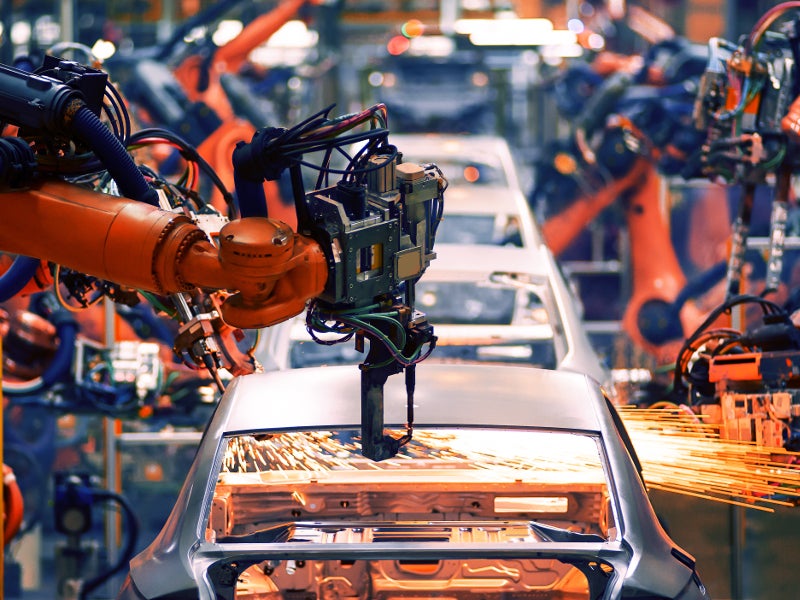
Industrial automation is, in essence, the reason why industrial companies are undergoing digitisation programs. Automation promises to bring down operational costs, improve process efficiencies, and enable the development of new digital services for customers. The rapid digitisation of Chinese industry is a significant driver, forcing others to adopt a razor-sharp focus on cost management.
Listed below are the top industrial automation technology trends, as identified by GlobalData.
Industry 4.0
Industry 4.0 is an over-arching term that describes the digitisation of industrial companies. The term, Industry 4.0 is overly hyped. This is unfortunate because at the heart of Industry 4.0 lies the promise of significant business process improvements and the development of new, data-driven business models. Industry 4.0 leverages the data created by IoT devices to provide companies with new, deep insights into their company’s operations. However, there are significant barriers regarding access to this data. Industry 4.0 will continue to be important, but progress will be slow. Companies will focus their investments on use cases that deliver high returns in the shortest time.
Industrial Internet
Within the industrial automation internet, data becomes the most important ingredient. Falling costs and competition among vendors will mean competitive differentiation is increasingly difficult in hardware. Multiple options for device connectivity will similarly drive down connectivity costs. However, as more devices produce more data, the most lucrative segments of the Industrial Internet value chain will shift towards applications. The availability of these new data sets will allow companies to improve operational efficiency and develop new business models. The claim that data is the new oil will remain accurate. Companies will consider investments in data management to be part of the Industrial Internet spend.
Industrial robots
Robots provide an alternative to human labour, particularly for repetitive tasks in hazardous environments. The automotive industry remains the leading user of robots in its production line. The largest industrial robot sector is caged robots. However, the fastest growing sector is collaborative robots, or co-bots. These are smaller, smarter, more mobile robots that work alongside humans. In 2018 the global robotics market was worth $98 billion, and it will have surpassed $275 billion by 2025, according to GlobalData. Existing users of robots will investigate new use cases, and new customers will investigate the technology. Advanced analytics, new functionality, lower costs, and increasing competition will be the primary drivers for adoption.
AI
Analytics is central to industrial automation. The level of analytics is reliant on the use case involved but, as the world’s leading data scientists push the boundaries of AI, new use cases in industrial automation open up. Industrial companies will ramp up investments into AI startups, competing directly with big technology companies. Expect to see rapid developments in chip design to support AI processing and the embedding of advanced chips in edge computing hardware.
Digital twin
Digital twin technology may not receive the same volume as other technologies, such as AI and blockchain, but it has hit peak hype. Digital twin is not any single technology. At its most basic level, a digital twin is a digital representation of a physical asset. How complex that representation gets is limited only by technological advancement and the asset owner’s requirements. 2020 will see more companies announce positive return on investment (ROI) on their digital twin projects, which will foster increased adoption and associated data management practices.
How well do you really know your competitors?
Access the most comprehensive Company Profiles on the market, powered by GlobalData. Save hours of research. Gain competitive edge.

Thank you!
Your download email will arrive shortly
Not ready to buy yet? Download a free sample
We are confident about the unique quality of our Company Profiles. However, we want you to make the most beneficial decision for your business, so we offer a free sample that you can download by submitting the below form
By GlobalData3D printing
In recent years, the focus of the 3D printing industry has shifted from prototyping to production. According to 3D Hubs, 75% of US and German automotive companies now use 3D printing to make parts. However, 3D printing is typically used to make small batches of a product. In 2020, 3D printing will take more steps into the mainstream. It will expand out from technology and innovation hubs into new industries.
AR
Industrial AR is a new approach to real-time IoT data visualisation. AR deployments are at an early stage, but a number of companies have adopted the technology, including BP, Honeywell, Boeing, and Ford. AR for industrial applications will most commonly use mobiles or tablets, rather than dedicated headsets or AR glasses. While AR ubiquity is still some way off, 2020 will see AR gain an increasing foothold across multiple industrial verticals.
Virtual reality (VR)
The integration of AI, cloud services, motion tracking, eye tracking, 3D audio, and haptics should enable second-generation VR devices to deliver immersive experiences. Enterprise adoption is accelerating in retail, tourism, and healthcare, but industrial adoption is low, despite a strong push from vendors. While use cases are heavily promoted in industrial settings, adoption remains well below vendors’ expectations. However, VR can add value in training staff.
Blockchain
Blockchain and its associated technologies burst into the public consciousness in 2015. The ability to execute transactions effectively without the presence of a central authority is regarded by many as the chief benefit of blockchain technology. However, this freedom comes at a very significant cost.
This is an edited extract from the Tech, Media, & Telecom Trends 2020 – Thematic Research report produced by GlobalData Thematic Research.





Related Company Profiles
BP Plc